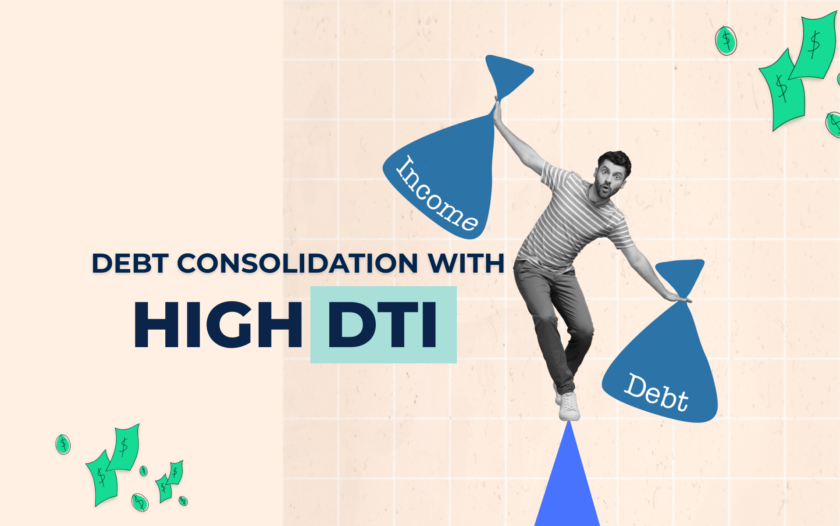How to Consolidate Debt with a High Debt-to-Income Ratio?
Thomas J. Brock, CFA, CPA, is a well-rounded financial professional, with over 20 years of experience in investments, corporate finance, and accounting. His investment experience includes oversight of a $4 billion portfolio for an insurance group. Varied finance and accounting work includes credit analyses, the development of multiyear financial forecasts, and the evaluation of capital budgeting proposals and investment opportunities. Beyond the corporate setting, he assists individuals and small businesses with accounting, financial planning, and investing matters; lends his financial expertise to a few well-known websites; and tutors students via a virtual forum.
About Trevor
Trevor Mahoney is a financial services writer and content creator based out of Los Angeles, California. He holds a Bachelors of Science in Finance from Santa Clara University. In his free time, he enjoys hiking and lounging on the beach.
Read full bio
At a Glance
While a debt consolidation loan allows you to pay off your existing debt by combining it into a single loan, lenders typically like to see a healthy debt-to-income or DTI ratio before lending to you. For those with higher debt levels this can seem like a troubling hurdle, but by learning to calculate your own DTI and the loan options available to you, you can improve your debt today.
To learn more about each, click below:
What is a high debt-to-income ratio?
The value considered to be a high debt-to-income ratio can fluctuate depending on the type of loan you seek, but generally a value above 43% is high. For some loans, such as consolidation loans, the max DTI lenders like to see may be as high as 50%, but it’s important to research every individual lender. As mentioned, these values can vary, but use the following as a rule-of-thumb:
- 0%-36%: This is a strong debt-to-income ratio that demonstrates you likely know how to manage your money effectively.
- 37%-43%: This is the middle-ground for a debt-to-income ratio where it’s still a strong chance that a person is managing their debt well, but more questions may be required.
- 44%-50%: This is where things begin to get high-risk and when lenders start to seriously question whether or not to approve an application.
- 50% and above: Those with a debt-to-income ratio in this category can essentially kiss their hopes of approval goodbye without additional information to support their case.
However, to answer the question of, “what is a high debt ratio?” properly you will need to calculate your own. By determining this value, you can also determine what debt consolidation strategies you may be eligible for.
How to calculate debt-to-income ratio?
The simple formula for calculating your debt-to-income ratio is to take all your existing monthly debt payments and divide the value by your monthly pre-tax income. Then, multiply the result by 100 to get your percentage. This may seem straightforward, but identifying all your debt payments can be challenging. Here is an example that may help you to visualize the process. Say you have the following monthly debt payments:
- Student loan payments: $300
- Credit card minimum payments: $200
- Auto loan payment: $400
This equates to a numerator of $900 in debt for the month. On top of this, say your pre-tax earnings are $3,000 for the month. When you divide these two values and multiply by 100, you get a debt-to-income ratio of 30%.
In addition to all of the above, there are other common expenses which fall into your debt-to-income ratio which are important to know about. The most notable of these include: monthly rent or mortgage payment, personal loan payments, child support or spousal support payments, and other types of loan payments.
Expert tip from Thomas Brock: Your debt-to-income ratio is important to potential lenders, because it indicates the proportion of your current income that goes toward servicing existing debts. The higher the ratio, the less financial flexibility you have and the greater the credit risk you pose to new lenders.
How high DTI can impact debt consolidation?
As mentioned, having a high DTI means that lenders will naturally consider you to be a higher risk than others who are applying for loans or credit cards. This means that some debt consolidation solutions such as balance transfer cards or personal loans, discussed further down, may not be viable strategies. The interest rate offered for debt consolidation strategies may also be higher than normal due to having a high DTI which will make the entire process of debt consolidation lengthier, as it will likely take longer to pay off the debt.
Options for debt consolidation with high DTI
Debt consolidation with high debt to income ratio can be a challenge, but there are various strategies and loan types to accomplish this goal. Specific high debt to income ratio loans, such as personal loans for high debt to income ratio, are designed to help those who may have a DTI above 40%.
1. Secured personal loan
While lenders may not be willing to provide you with an unsecured personal loan when you have a high DTI ratio, they may offer you a secured personal loan. The primary difference between these two types is that a secured loan requires a borrower to put down collateral. This collateral can be anything from your car to other assets you may own. The reason lenders are more willing to offer a secured personal loan to somebody with a high DTI is that in the event of non-payment by the borrower, the lender can still collect on something of value. Read more on the differences between secured and unsecured loans here.
Related: Secured vs Unsecured Personal Loans
2. Home equity loan
A home equity loan is a secured type of loan in which a borrower receives funds in exchange for offering equity in their home as collateral. As discussed earlier, this allows the lender to perceive the borrower as having less risk, so they are more willing to provide the loan. The amount of the loan is determined by the value of the property as determined by an appraiser.
Related: Best Home Equity Loans
3. Loan with a co-signer
Lenders have certain requirements you must meet in order to get approved for a loan, such as a minimum credit score or income requirements. If you don’t have these, a cosigner can help the lender feel more comfortable giving you the loan. Because someone else is pledging to repay the loan if you don’t, the loan is considered less risky.
Personal Loans with a Co-Signer
Use the filters below to refine your search

Sorry, we didn’t find any options that meet your requirements. Please try modifying your preferences.
Congratulations! You’re close to seeing your offers!
Please take a second to review the details you shared earlier
Sorry, we didn’t find any options that meet your requirements. Please try modifying your preferences.
4. Credit card balance transfer
A credit card balance transfer occurs when the value of debt on one or more credit cards is transferred over to a new card. The reason for doing this and why it’s such an effective strategy for debt consolidation is that the APR on a new credit card may be more favorable on the old card which means a person can save money on interest. Additionally, many credit cards offer 0% introductory APR periods on balances transferred which means a person can buy themselves time to pay off their debt without any interest.
Learn more: Balance Transfer Credit Cards
5. Cash out refinance
Cash out refinancing is when a person takes a portion of their equity in the form of cash in order to pay off existing debt. This amount is then absorbed by the lender who you now owe money too in the form of a new mortgage amount with monthly installments.
Other options to consolidate debt with high DTI
The primary alternatives to debt consolidation loans involve methods of reducing debt. Therefore, some of the best ways to learn how to consolidate your debt without getting a loan are:
1. Seeking credit counseling
By learning how to improve your credit with the help of a professional, you can improve your debt-to-income ratio and potentially be approved for a loan in the future. Credit counselors will work with individuals to develop repayment plans and work on strategies for managing debt overall. This can help you to get a lower monthly payment and interest rates through the creation of a management strategy. The best choices for credit counseling are National Foundation for Credit Counseling or the Financial Counseling Association of America.
Expert tip from Thomas Brock : Debt consolidation entails taking out a new loan to retire multiple existing loans. It makes sense when you can achieve a lower interest rate on the new loan than the weighted average rate on your existing debts. It makes even more sense when you can also implement a shorter overall term.
2. Debt consolidation program
A debt consolidation program is when a company communicates with lending agencies on your behalf in an effort to negotiate better terms. They assume the risk on your behalf, and your payments of the loan go to the company rather than the lender. Many government-approved debt consolidation programs are designed for those seeking how to get a loan with high debt-to-income ratio.
3. Settle your debt
Debt settlement companies allow you to pay off a portion of your existing debt and, in return, they will pay off your debt in some cases. Debt settlement counselors can help you negotiate with your creditors directly so that they agree to accept a lower payment than what you owed in full. Debt settlement is best when there is a substantial amount left to be paid on your account but you are several months behind on your payment and cannot foreseeably meet that payment in the future.
4. Declare bankruptcy
This should only be used as a last resort, as declaring bankruptcy can have longstanding implications on your finances. However, it can also allow you to reduce your debt in the event you cannot meet any of your payments. To file for bankruptcy means to file for Chapter 7 or Chapter 13 which are liquidation and reorganization, respectively. This process will occur through the court system which means creditors cannot back out as they can with debt settlement or debt management.
How to lower debt-to-income ratio?
High debt to income ratio lenders would still like to see your DTI come down over time, so learning how to reduce this figure should remain important.
1. Pay off your loans ahead of your schedule
By paying off your loan balances in advance, in full, you can avoid accruing interest on your balances. In the long term, this will reduce the overall debt you have remaining to pay and will decrease the numerator for your DTI calculation.
2. Restructure your debts
By speaking with the lenders for your various forms of debt, you may be able to restructure the terms of your loans or debts. Extending loan terms by a couple years may help reduce interest rates or principal payments. As just discussed, transferring your credit cards to a single card may result in a lower interest rate and less debt as a whole.
3. Increase income
To decrease your debt-to-income ratio for a debt consolidation loan, focusing on the denominator of the equation can be an excellent strategy if your debt is locked. Finding a second job or seeking higher pay at a different organization can be a quick way to reduce your debt-to-income level.
FAQs
In most cases, yes, a debt consolidation loan will help your DTI ratio by reducing the amount of monthly payment you make on your debt and reducing the number of interest rates you pay. A debt-to-income ratio of 36% and under is good, while anything above this value becomes increasingly more concerning for lenders. In general, you will be hard-pressed to find lenders willing to loan when your DTI is in the range of 46-50%. A person’s income is not included in their credit score report, so your DTI ratio will never affect your credit score. However, debt by itself can affect your credit score if you are missing payments, so always be sure to meet your debt obligations in full. A debt consolidation loan with high utilization can negatively impact your debt-to-income ratio. Credit utilization is simply the amount of available credit you are currently using that is not yet paid off. As a result of not being paid off yet, it factors into the numerator of your debt-to-income ratio.









